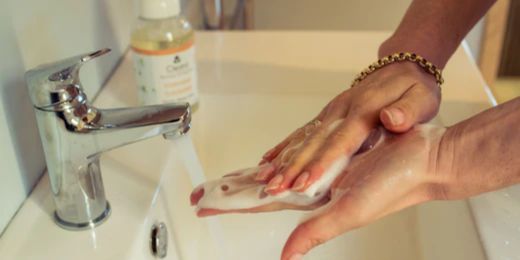FREE NATIONWIDE SHIPPING ON ORDERS $69 AND OVER
FREE NATIONWIDE SHIPPING ON ORDERS $69 AND OVER
Add description, images, menus and links to your mega menu
A column with no settings can be used as a spacer
Link to your collections, sales and even external links
Add up to five columns
Add description, images, menus and links to your mega menu
A column with no settings can be used as a spacer
Link to your collections, sales and even external links
Add up to five columns

What's wrong with using Hand Sanitisers and Antibacterial soaps?
August 04, 2022 3 min read
What's wrong with using Hand Sanitisers and Antibacterial soaps?
This subject is a bit of a rabbit hole - but I have tried to unravel a lot of data and create something simple to read, without losing the gravity of what has occurred.
Up until the 1980's, soap and water were what the population (including healthcare workers) used to wash their hands.
Then the commercial soap industry began developing soaps for healthcare that contained the ingredient Triclosan, which was promoted as an antibacterial ingredient.
Although Triclosan had been registered as a pesticide in 1969, the industry embraced the antibacterial revolution. It wasn't long before antibacterial soaps and other personal care products, containing Triclosan (and over 250 other antibacterial chemicals) found their way onto the supermarket shelves.
In 1997 the US government (FDA) concluded that Triclosan and many other antibacterial ingredients were safe and there was no evidence linking antimicrobial products to antibacterial resistance.
By 2000 a marketplace study found that over a billion dollars were being spent on these products and that 75% of liquid soaps and 30% of bar soaps contained some type of antibacterial agent and half of all commercial soaps contained Triclosan.
In 2002 in a random study of 2500 people, 75% were found to have Triclosan in their urine samples. Another study by the Mount Sinai School of Medicine on 90 girls aged between 6 and 8 found that 61% had Triclosan detected in their urine samples.
Triclosan was also beginning to be detected in breast milk.
Lab studies link Triclosan to cancer, developmental defects, and liver and inhalation toxicity, and it is suspected to be a cause of hormone and thyroid disruption.
In 2013, the FDA announced a bold new position on antibacterial soap: Manufacturers had to show that their products were both safe and more effective than simply washing with conventional soap and water, or they had to take it off the shelves.
By 2016 the FDA banned Triclosan and 17 other chemicals used in hand and body washes in consumer products and in December 2017 the FDA banned Triclosan in hospitals.
As a result of the US ban, New Zealand scientists called for triclosan to also be banned here.
We have been making efforts to ensure the “called for ban” is implemented.
Recently, the CDC ( Centre for Disease Control) says washing hands with soap and water is your best prevention, especially after using the bathroom, changing a nappy, and before eating and doing food prep. Sanitisers may help, but “they are not a substitute for washing with soap and water.”
In addition,
“To date, studies have shown that there is no added health benefit for consumers using soaps containing antibacterial ingredients compared with using plain soap.”
In summary, antibacterials and hand sanitisers are at best less effective and at worst can increase the instance of drug-resistant bacteria, undermine our immune systems, and disrupt our hormones and thyroid.
4 Steps to healthy hands
- Stop using antibacterial soaps especially if their ingredients are not listed.
- Use a plain soap or surfactant product like Cleanz foaming hand soap. These products lift the bacteria off your hands and get washed down the drain.
- Wet your hands with clean running water, then lather your hands with soap or foaming hand soap for at least 20 secs.
- Rinse your hands and dry with a clean towel or air dryer.
Leave a comment
Comments will be approved before showing up.

